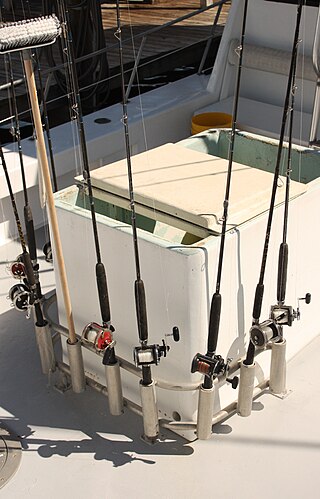
A fishing rod is a long, thin rod used by anglers to catch fish by manipulating a line ending in a hook. At its most basic form, a fishing rod is a straight rigid stick/pole with a line attached to one end ; however, modern rods are usually elastic and generally have the line stored in a reel mounted at the rod handle, which is hand-cranked and controls the line retrieval, as well as numerous line-restricting rings that distribute bending stress along the rod and help dampening down/prevent line whipping and entanglement. To better entice fish, baits or lures are dressed onto the one or more hooks attached to the line, and a bite indicator is used, some of which might be incorporated as part of the rod itself.

A fishing line is any flexible, high-tensile cord used in angling to tether and pull in fish, in conjunction with at least one hook. Fishing lines are usually pulled by and stored in a reel, but can also be retrieved by hand, with a fixed attachment to the end of a rod, or via a motorized trolling outrigger.

Fly fishing is an angling technique that uses an ultra-lightweight lure called an artificial fly, which typically mimics small invertebrates such as flying and aquatic insects to attract and catch fish. Because the mass of the fly lure is insufficient to overcome air resistance, it cannot be launched far using conventional gears and techniques, so specialized tackles are used instead and the casting techniques are significantly different from other forms of angling. It is also very common for the angler to wear waders, carry a hand net, and stand in the water when fishing.

Fly tying is the process of producing an artificial fly used by fly fishing anglers to catch fish. Fly tying is a manual process done by a single individual using hand tools and a variety of natural and manmade materials that are attached to a hook. Although the recent history of fly tying dates from the middle 1800s, fly tyers were engaged in tying flys since at least 200 AD.

The Woolly Bugger is an artificial fly commonly categorized as a wet fly or streamer and is fished under the water surface. It is a popular and widely used pattern for both freshwater and saltwater game fish and is generally listed as one of the top patterns to have in any fly box. John Gierach, a noted fly fishing writer discussed the Woolly Bugger first in his chapter on streamers in Good Flies. Woolly Buggers are typically fished in streams, rivers, ponds, lakes, and tidal flats. Today, Woolly Buggers are tied in a wide variety of styles and colors to imitate a wide range of game fish prey.
The Woolly Bugger is so effective, it should be banned from some watersheds. I suspect its effectiveness is due to its resemblance to so many edible creatures in the water—nymphs, leeches, salamanders, or even small sculpins. Its tail undulating behind a fiber, bubble-filled body is just too much for most fish to resist. It just looks like a meal!

The Muddler Minnow is a popular and versatile artificial fly of the streamer type used in fly fishing and fly tying.

Fishing tackle is the equipment used by anglers when fishing. Almost any equipment or gear used in fishing can be called fishing tackle, examples being hooks, lines, baits/lures, rods, reels, floats, sinkers/feeders, nets, spears, gaffs and traps, as well as wires, snaps, beads, spoons, blades, spinners, clevises and tools that make it easy to tie knots.

An artificial fly or fly lure is a type of fishing lure, usually used in the sport of fly fishing. In general, artificial flies are an imitation of aquatic insects that are natural food of the target fish species the fly fishers try to catch. Artificial flies are constructed by fly tying, in which furs, feathers, thread or any of very many other materials are tied onto a fish hook.
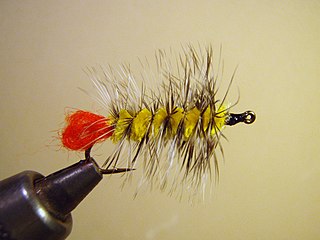
The Woolly Worm is an artificial fly commonly categorized as a wet fly or nymph and is fished under the water surface. It is a popular pattern for freshwater game fish and was a very popular fly in the 1950s–1970s in the west. Charles Brooks in Nymph Fishing for Larger Trout recommends the Woolly Worm as a general purpose nymph pattern in most western trout waters in any fly box. Woolly Worms are typically fished in streams, rivers, ponds, and lakes for trout, bass, and panfish. Today, Woolly Worms are tied in a variety of styles and colors to imitate a large aquatic nymphs such as stoneflies, dragonflies, damselflies or hellgrammites.
Fly fishing tackle comprises the fishing tackle or equipment typically used by fly anglers. Fly fishing tackle includes:
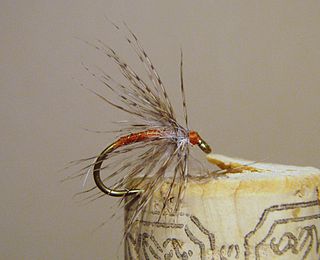
The Partridge and Orange is an artificial fly commonly categorized as a wet fly or soft hackle and is fished under the water surface. The fly is a very well known fly with its roots set firmly in English angling history. It is an impressionistic pattern fished successfully during caddis hatches and spinner falls. The Partridge and Orange is traditionally a trout and grayling pattern but may be used for other aquatic insect feeding species.

The Royal Coachman is an artificial fly that has been tied as a wet fly, dry fly and streamer pattern. Today, the Royal Coachman and its variations are tied mostly as dry flies and fished floating on the water surface. It is a popular and widely used pattern for freshwater game fish, particularly trout and grayling. Large streamer versions are also used for winter steelhead and Atlantic salmon.
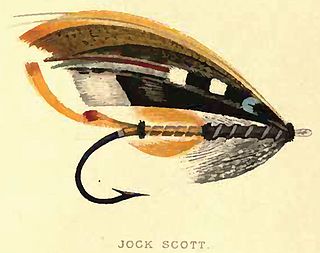
Fully dressed flies are elaborate and colorful artificial flies used in fly fishing. The most famous of these are the classic salmon flies, which are exquisite patterns made from mostly rare and beautiful materials and feathers, including golden pheasants, toucans, swans, and ivory-billed woodpeckers. These flies have been popular in the United Kingdom since the 19th century. Fully dressed flies are often meant for display and are not used in actual fishing. Many patterns are expensive to tie because of the cost of rare feathers.
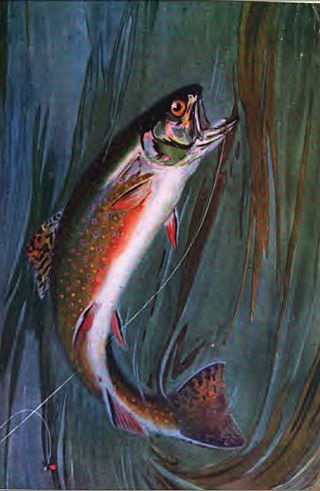
This annotated bibliography is intended to list both notable and not so notable works of English language, non-fiction and fiction related to the sport of fly fishing listed by year published. Although 100% of any book listed is not necessarily devoted to fly fishing, all these titles have significant fly fishing content. Included in this bibliography is a list of species related fly fishing literature.

This annotated bibliography is intended to list both notable and not so notable works of English language, non-fiction and fiction related to the sport of fly fishing listed by year published. Although 100% of any book listed is not necessarily devoted to fly fishing, all these titles have significant fly fishing content. Included in this bibliography is a list of fly tying, fly tackle, regional guides, memoirs, stories and fly fishing fiction related literature.
Lee Wulff, born Henry Leon Wulff, was an artist, pilot, fly fisherman, author, filmmaker, outfitter and conservationist who made significant contributions to recreational fishing, especially fly fishing and the conservation of Atlantic Salmon.

The Crazy Charlie is a bonefish fly for saltwater fly fishing developed on Andros Island in 1977 in the Bahamas by local bonefish guide Charlie Smith and popularized by San Francisco angler Bob Nauheim. They fly was developed to imitate glass minnows, a common forage for bonefish on the nearshore flats of south Florida and Caribbean islands. The Crazy Charlie has become a staple fly for bonefish and permit anglers around the globe.

The Wulff series of dry flies evolved from a dry fly style conceived by angler Lee Wulff in the 1930s.
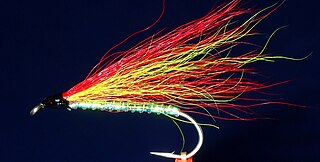
The Mickey Finn is a historic and effective bucktail streamer used by fly anglers for trout, warm-water and saltwater species. The fly is somewhat generic and imitates a wide variety of baitfish. Although most likely originated in the late 19th century by Eastern Canadian anglers, the Mickey Finn pattern once known as the Red and yellow bucktail was popularized by angler and author John Alden Knight in 1937.

Bonefish fly patterns are a collection of artificial flies routinely used by fly anglers targeting various species of Bonefish. Bonefish frequent tidal sand and mudflats in tropical and sub-tropical latitudes to feed on benthic worms, fry, crustaceans, and mollusks. Bonefish have small mouths and most Bonefish flies are tied on size 4 to 8 saltwater fly hooks.























